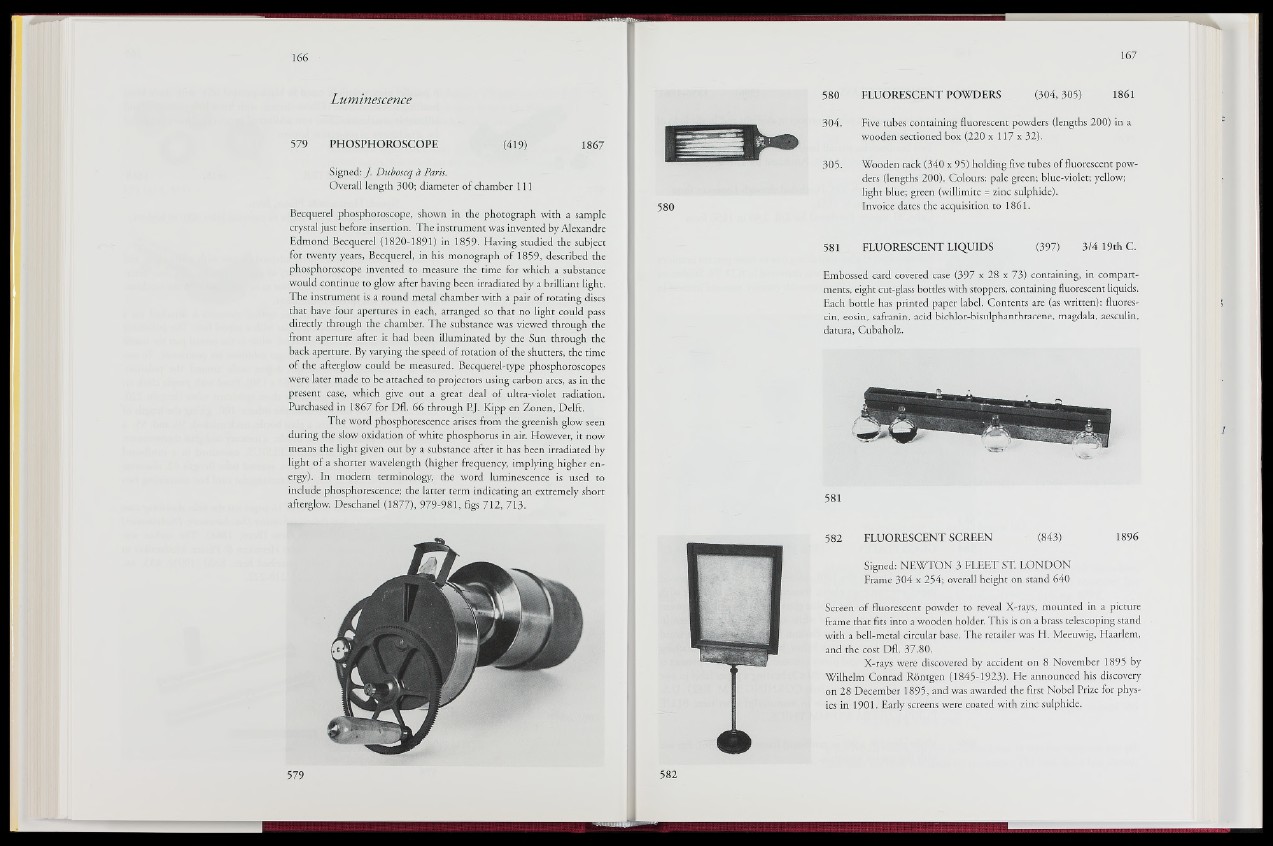
Luminescence
579 PHOSPHOROSCOPE - ,(419) 1867
Signed: J. Duboscq à Paris.
Overall length 300; diameter of chamber 111
Becquerel phosphoroscope, shown in the photograph with a sample
crystal just before insertionfflThe instrument was invented by Alexandre
Edmond Becquerel (1820-1891) in 1859. Having studied the subject
for twenty years, Becquerel, in his monograph of 1859, described the
phosphoroscope invented to measure the time for which a substance
would continue to glow after having been irradiated by a bMjgit light.
The instrument is a round metal chamber with a pair of rotating discs
that have four apertures in each, arranged so that no light could pass
directly through the chamber. The substance was viewed through the
front aperture after it had been illuminated by the Sun through the
back aperture. By varying the speed of rotation of the shutters, die time
of the afterglow could be measured. Becquerel-type phosphoroscopes
were later made to be attached to projectors using carbon arcs, as in the
present case, which give out a great deal o f ultra-violet radiation.
Purchased in 1867 for Dfl. 66 through P.J. Kipp en Zonen, Delft.
The word phosphorescence arisesirom the,greenish glow seen
during the slow oxidation of white phosphorus iojjr. However;* now
means the light given out by a substance after it has been irradiated by
light of a shorter wavelength (higher frequency, implying higher energy).
In modern terminology, the word luminescence is used ttft
include phosphorescence;, the latter term® dicating an extremely shora
afterglow. Deschanel (18^^979-981, figs 712(if 13.
580 FLUORESCENT POWDERS (304,305) 1861
304. Five tubes containing fluorescent powders (lengths 200) in a
wooden sectioned box (220 x 117 x 32).
305. Wooden rack (340 x 95) holding five tubes of fluorescent powders
(lengths 200). Colours: pale green; blue-violet; yellow;
light blue; green (willimite = zinc sulphide).
Invoice dates the acquisition to 1861.
581 FLUORESCENT LIQUIDS (397|‘ 3 /4 19th C.
Embossed card covered case (397 x 28 x J§| containing, in compartments,
eight cut-glass bottles with stoppers, containing fluorescent liquids.
Each bottle has printed paper label. Contents are (as written): fluores-
cin, eosin, safranin, acid|Si|hlor-bisulphanthracene, magdala, aesculin,
datura, Cubahol^M
581
582 FLUORESCENT SCREEN - (843) 1896
Signed: NEWTON 3 FLEET ST. LONDON
Frame 304 x 25B overall height on stand 640
Screen of fluorescent powder to reveal X-rays, mo|§Sted in fi| picture
frame that fits into a wooden holder. This is on a brass telescoping stand
with a bell-metal circular base. The retailer was H. Meeuwig, Haarlem,
and the go'st Dfl. 37.80.
X-rays were discovered by accident on 8 November 1895 by
Wilhelm Conrad Röntgen (1845-1923J. He announced his discovery
on 28 December 1895, and was awarded the first Nobel Prize for physics
in HO 1. Early screens were coated with zinc sulphide.